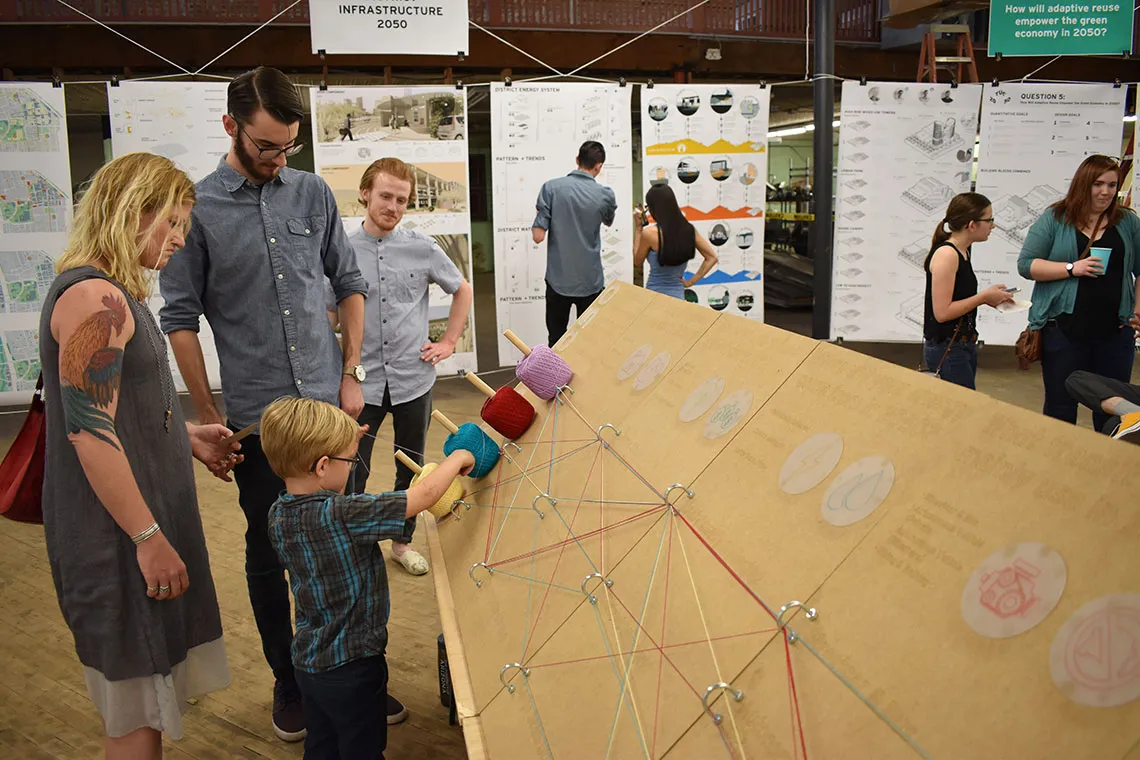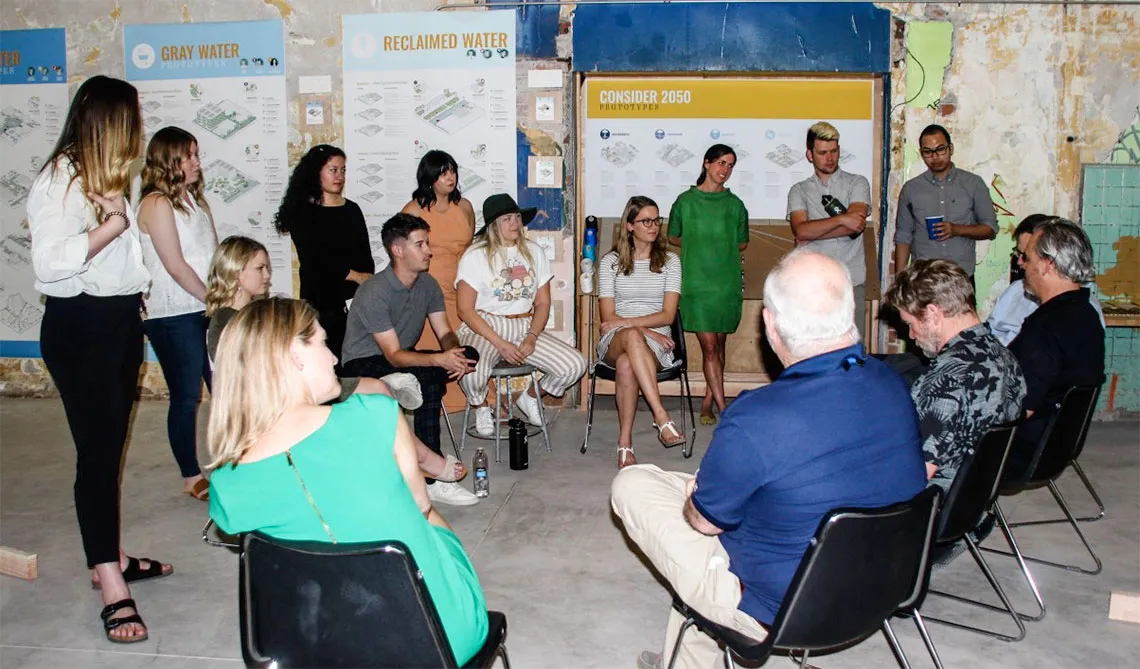UArizona Architecture Students Design a More Sustainable Tucson Thanks to CAPLA Partnership with GLHN

Downtown Tucson 2050 exhibition and presentation by CAPLA Bachelor of Architecture students, under the guidance of Assistant Professor of Architecture Courtney Crosson and in partnership with GLHN. Photo by Courtney Crosson.
In 2017, Courtney Crosson, assistant professor of architecture at the University of Arizona’s College of Architecture, Planning and Landscape Architecture, had a vision: let students define the future of the city they had become so intimate with during their time in architecture school.
Crosson and her students were not the only people thinking about Tucson’s future, of course. With the successful launch of Tucson’s SunLink streetcar two years earlier, designers, developers, planners and policymakers across the region were considering what a more sustainable future could look like.
Yet “architecture students are superb at visual renderings and setting a vision,” says Crosson, so why not let students drive what the community could be by 2050—the year in which the students themselves would be around 50 years old and at the height of their professions?
At the same time, GLHN Architects & Engineers President Henry Johnstone and Director of Architecture Brian Hagedon ’89 B.Arch were evaluating alternative ways to support CAPLA students after funding scholarships for several years. Johnstone too was thinking about how students could play a part in designing Tucson’s future. When CAPLA approached GLHN about sponsoring a series of advanced Bachelor of Architecture studios, Crosson and Johnstone combined their vision and the firm signed on.

Postcards designed by CAPLA students for the Downtown Tucson 2050 Exhibit. Image courtesy Courtney Crosson and ARC 451A Spring 2018 students.
“These studios not only create a real and lasting connection between GLHN and the students, they also challenge the students to work through the real-life obstacles of getting a visionary project off the ground,” Hagedon says.
The partnership provides a path not only for studio sponsorship, but also for technical advising to the students. And thanks to the formation of strong relationships during their work together, GLHN has since hired several CAPLA students who participated in the studios.
“GLHN believes in a direct connection between our community’s approach to long-range planning and the design of energy, water, transportation, community health, buildings and livability,” says Johnstone. “Through their collaboration, research and design, these studios can direct Tucson toward a thriving urban center that drives robust economic development.”
As the students craft their visions for a more sustainable Tucson, they are also mentored by representatives from community organizations and city and county offices. At the end of their projects, they then present their recommendations in a public setting in concert with publication of a comprehensive, design-oriented report.
The first studio, comprised of seven fourth-year B.Arch and three MLA students, was completed in 2017 and proposed a Tucson ecodistrict as an answer to the question of what Tucson will look like in 2050. Students worked with six community mentors to conduct case study research, spatial mapping, quantitative analysis and design inquiry. Their work resulted in three primary components: 1) sustainable “building-block” prototypes to answer fundamental questions posed by the community mentors; 2) district energy, transportation, water and living infrastructure for downtown in 2050; and 3) three sub-district rendered visions (Congress, Tucson Convention Center and Mercado). Students presented their work via a report and final review to community partners at the end of the Spring 2017 semester.
View the report: 2050: Downtown Tucson EcoDistrict.

At the public exhibition and presentation for Downtown Tucson 2050. Photo by Courtney Crosson.
The following year, 11 B.Arch students created their vision for a future downtown, working with additional community mentors representing Development Services and Energy Management with the City of Tucson and Transportation, Natural Resources and Sustainability Programs with Pima County. In their recommendations for what Tucson will be in 2050, the students explored how multimodal transportation increases livability, how a healthy and active population can be supported, how technology can expand adaptability, how the natural environment will improve quality of life and how adaptive reuse will empower the green economy. In addition to their comprehensive report, the students presented their work in downtown Tucson in May 2018.
View the report: Tucson 2050: A Vision for a Future Downtown.

Energy 2050, Transportation 2050 and Water 2050 Components designed by CAPLA students. Graphic courtesy Courtney Crosson and ARC 451A Spring 2018 students.
In 2019, students created a vision for a water-independent downtown Tucson. The 10 B.Arch students were mentored by representatives from Tucson Water, Pima County Regional Flood Control and Pima County Regional Wastewater Reclamation. Through case study research, spatial mapping, quantitative analysis and design inquiry, the students created 1) three sub-district rendered visions that achieve water independence: Congress (The Rising Aquifer), TCC (The Direct Potable Paradise) and Mercado (The City of Rain); 2) 20 prototypes for the development of downtown Tucson in 2050 that maximize the beneficial use of groundwater, stormwater, rainwater, gray water and reclaimed wastewater; 3) integrated water, energy, transportation and living infrastructure; and 4) interactive engagement activities including virtual reality renderings, models, video and comment boards designed to connect Tucson’s sustainable water ambitions with the future of downtown in 2050. In addition to their report, the students held an open house and public presentation at the end of the Spring 2018 semester.
View the report: One Water: Downtown Tucson 2050.

Students, City of Tucson and Pima County community members, and GLHN representatives debrief after the opening of the One Water exhibition in downtown Tucson, 2019. Photo courtesy Courtney Crosson.
This fall, the geographic range has expanded beyond downtown. The studio comprised of 10 fifth-year B.Arch students is exploring long-term sustainability issues facing urban food systems across the metro area—with a particular focus on the food-water-energy nexus. Their work will represent five typologies for the future of food systems in Tucson, each at a different site and paired with a local organization deeply engaged in this work: river adjacent (Mission Garden), community garden (Pima County Regional Flood Control District site), backyard farming (speculative site), food hub (Las Artes Arts and Education Center) and indoor-controlled agriculture (Merchant’s Gardens, a converted former school). A final end-of-semester exhibit will engage the public at Mission Garden and also result in a comprehensive report.
“In asking what Tucson can be in 30 years, University of Arizona architecture students are uniquely positioned to present well-researched, well-developed solutions,” says Crosson. “Our fourth Tucson 2050 studio completes the framing, over several years, of a comprehensive vision for our community that is much more than academic work. The students present beautiful, practical solutions of a truly sustainable future for our city across built, natural and social systems.”



